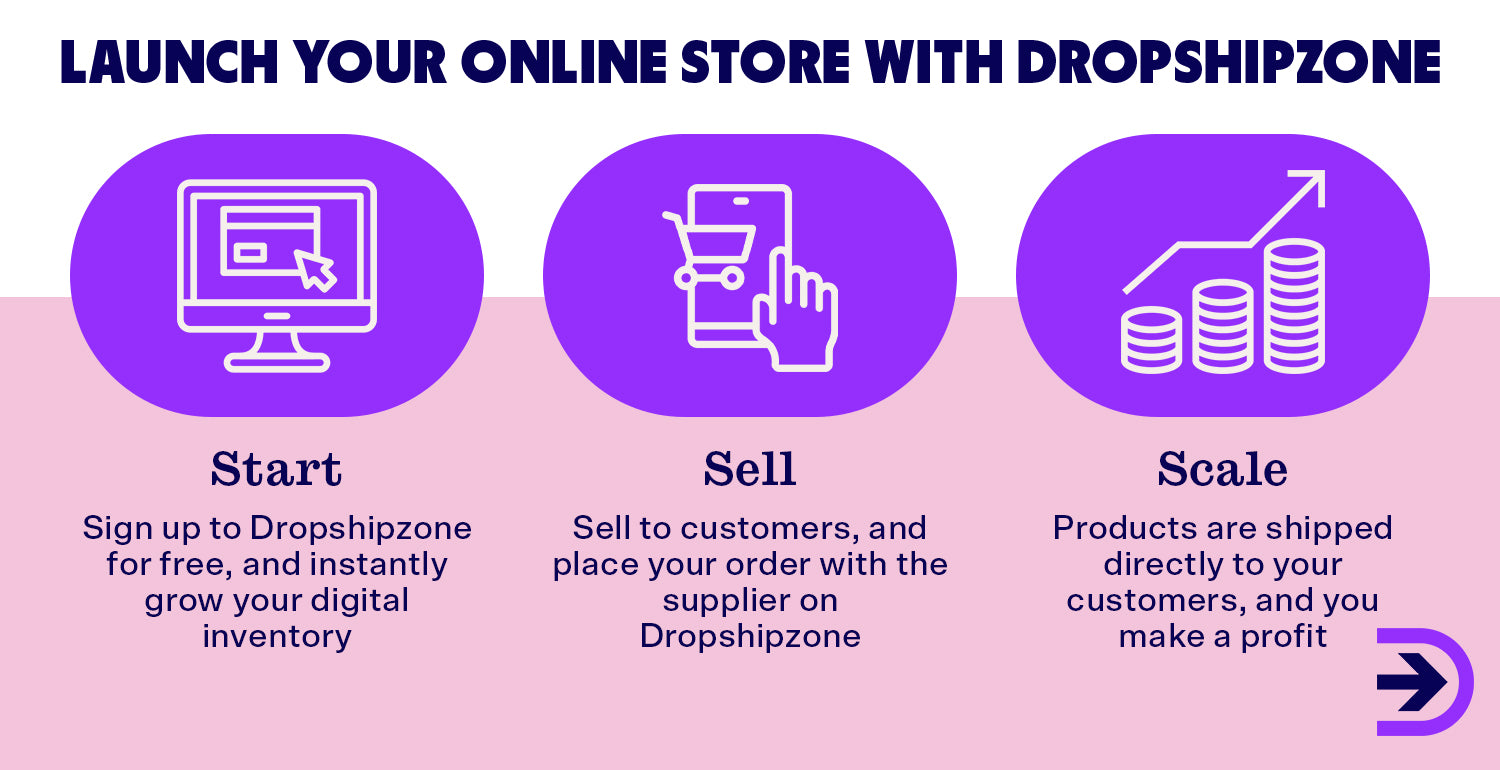8 Tips for Choosing the Perfect Dropshipping Store Name
Your business name is one of the most important identifiers for your brand. A brand name communicates a lot to customers regarding what a business sells and sets the tone of the brand. The right business name can catapult your online business to success. A bad business name can cost you hundreds, if not thousands of marketing dollars. You could also be liable for trademark infringement, which can have severe repercussions. When choosing a business name, you need to make it count.
Competition in the online retail space is higher than ever. There was a 204 per cent year-on-year growth in ecommerce sites in 2021 alone, and there are currently over 26.5 million ecommerce sites operating worldwide. With such heavy competition, having a unique brand identity is more important (and more difficult) than ever. Choosing the perfect business name can help your online store stand out from the crowd and make a good first impression. To help you get started, we’ve created a handy guide on how to choose the right name for your dropshipping business.
The Significance of Your Dropshipping Business Name
A business name lays the foundation of a brand’s identity and helps online businesses stand out amongst the competition. For most customers, your business name will be their first point of contact with your brand. It can take customers five to seven impressions to recognise your business logo, but only seven seconds to form a lasting impression of your brand. The right brand name makes it easy for customers to find, recognise and recommend your online store no matter what you sell. In fact, 77 per cent of people refer to certain items by brand names, such as Band-Aid, Q-tips, Crockpot and ChapStick. It is also the first point of contact for suppliers. 82 per cent of investors use name recognition as a guiding factor in their investment decisions. A good dropshipping store name will show suppliers that your dropshipping business has the potential to grow. Your potential suppliers will also know that you have performed market research and possess knowledge about how online business works.
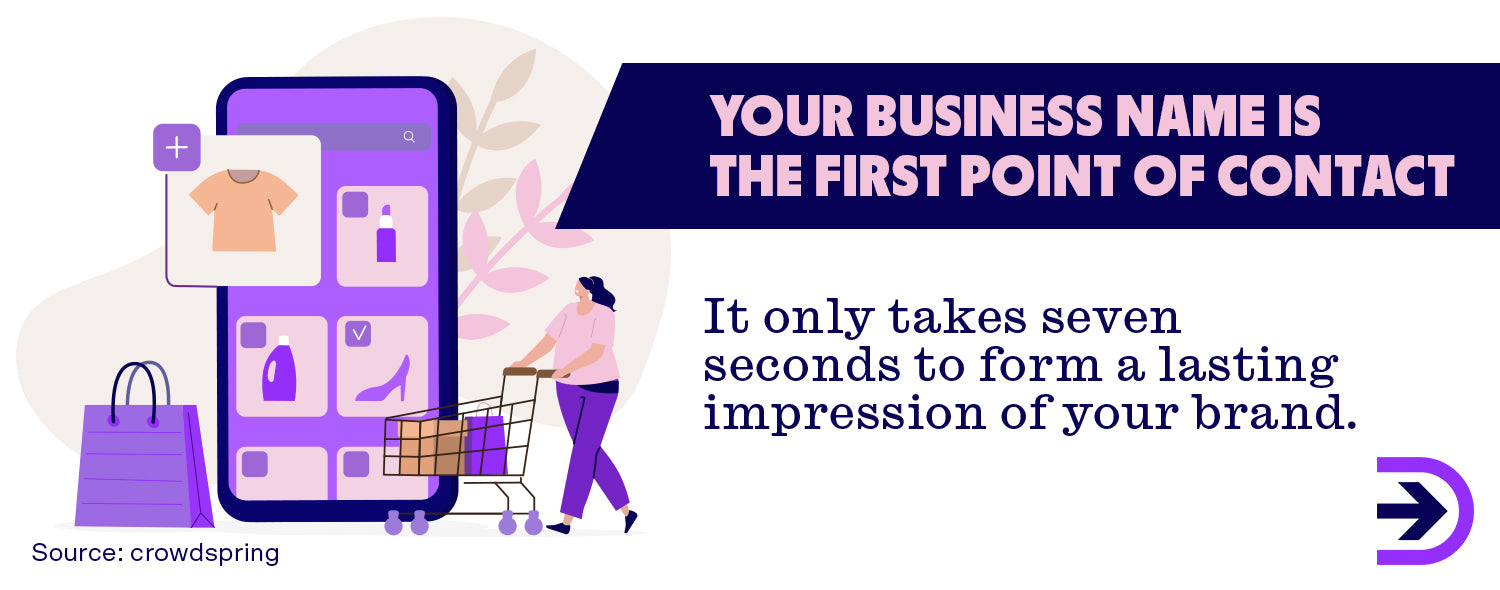
Choosing the right name for your dropshipping store also saves money. Rebranding costs businesses on average 5-10 per cent of their annual marketing budget per year. A full brand overhaul can cost companies around $225,000 to $350,000 over 9-12 months, and that’s not including the cost of lost brand recognition. That’s why it’s important for businesses to get the right brand name on the first try.
Types of Business Names
Acronyms
A common type of business name, acronyms are ideal for businesses with long or confusing names. For this reason, many science and tech giants use acronyms for their names, such as IBM (International Business Machines), NASA (National Aeronautics and Space Administration) and BP (British Petroleum). Acronyms have less meaning attached to them than other types of business names, but this can be advantageous for businesses looking to rebrand or expand their product and service range. For example, in 2018 fitness and weight loss company Weight Watchers changed its name to WW International in an effort to disconnect the brand from the negative connotations associated with ‘diet culture’. Instead, the brand now focuses on a holistic, body-positive view of health. Other big brands using acronymic names include BMW (Bayerische Motoren Werke GmbH), H&M (Hennes and Mauritz) and ASOS (As Seen on Screen).
Descriptive names
Descriptive business names describe the product or service offered in simple terms. The benefit of a descriptive name is that it conveys what your business is from the start. Consumers don’t need to read far to understand that they can store their savings at a Commonwealth Bank and send letters via Australia Post. Descriptive names are transparent, eliminating guesswork for customers and promoting trustworthiness and reliability. They have excellent searchability and higher visibility than other names. However, descriptive names can also be overly simplistic, generic, forgettable or bland, meaning businesses have to work harder on promoting their identity and brand promise through logos, taglines and content. Some descriptive business names include Paypal, Booking.com, Toys R Us, and Dropshipzone.
Evocative names
Evocative brand names attempt to convey certain emotions through metaphor or suggestion. These businesses want customers to feel a specific way when using their products or services. Visa began as BankAmericard in the 1950s and was known under many other names internationally throughout the 70s before the card was renamed Visa. The name was chosen for two reasons: firstly, it was easily recognised and pronounced worldwide. Secondly, it was a name that suggested acceptance, reinforcing the core promise and unique selling proposition of the Visa card - that it could be used anywhere in the world. By inducing emotions through evocative language, businesses are more likely to resonate with their target audience, create desire for their products, and motivate customers to action. Successful businesses with evocative names include Uber, Apple, Nike and Lush.
Geographical names
Businesses tied to a specific geological location may benefit from a geographical business name. These names are ideal for businesses with historical ties to an area or location-specific target audiences. Bega Cheese is one of Australia’s most popular cheese producers, named after the original factory location in the Bega Valley in New South Wales. The company was founded as a dairy cooperative in 1899 and has been producing Australian-sourced cheese on location ever since. The company now employs over 500 staff in the Bega Valley and exports approximately 20% of overall production to over 50 countries. Fiji Water is another brand that uses location in another way, by highlighting the clean and clear waters of Fiji to bring consumers across the globe “The Earth’s Finest Water”. Geographical names can carry historical significance, a sense of authenticity, and an implication of quality from the source. Other popular businesses with geographical names include Australian Geographic, The New York Times, Arizona Tea and Victoria Bitter.
Invented names
Did you know that 72 per cent of the top brand names are completely made up? Invented brand names are completely fabricated, and many have become household names that we use every day. These can be invented by combining two words, intentionally misspelling existing words, or simply conjuring something that sounds like a word. The most visited website in the world, Google’s name is actually a misspelling of the mathematical term googol, which is an equivalent of ten raised to the power of 100. Velcro is another common household name imagined by inventor George de Mestral when he combined the French words ‘velour’ (velvet) and ‘crochet’ (hook). Invented names are the easiest to trademark, but the hardest to produce. Other famous invented brand names include Kodak, Smiggle, Woolworths and Dulux.
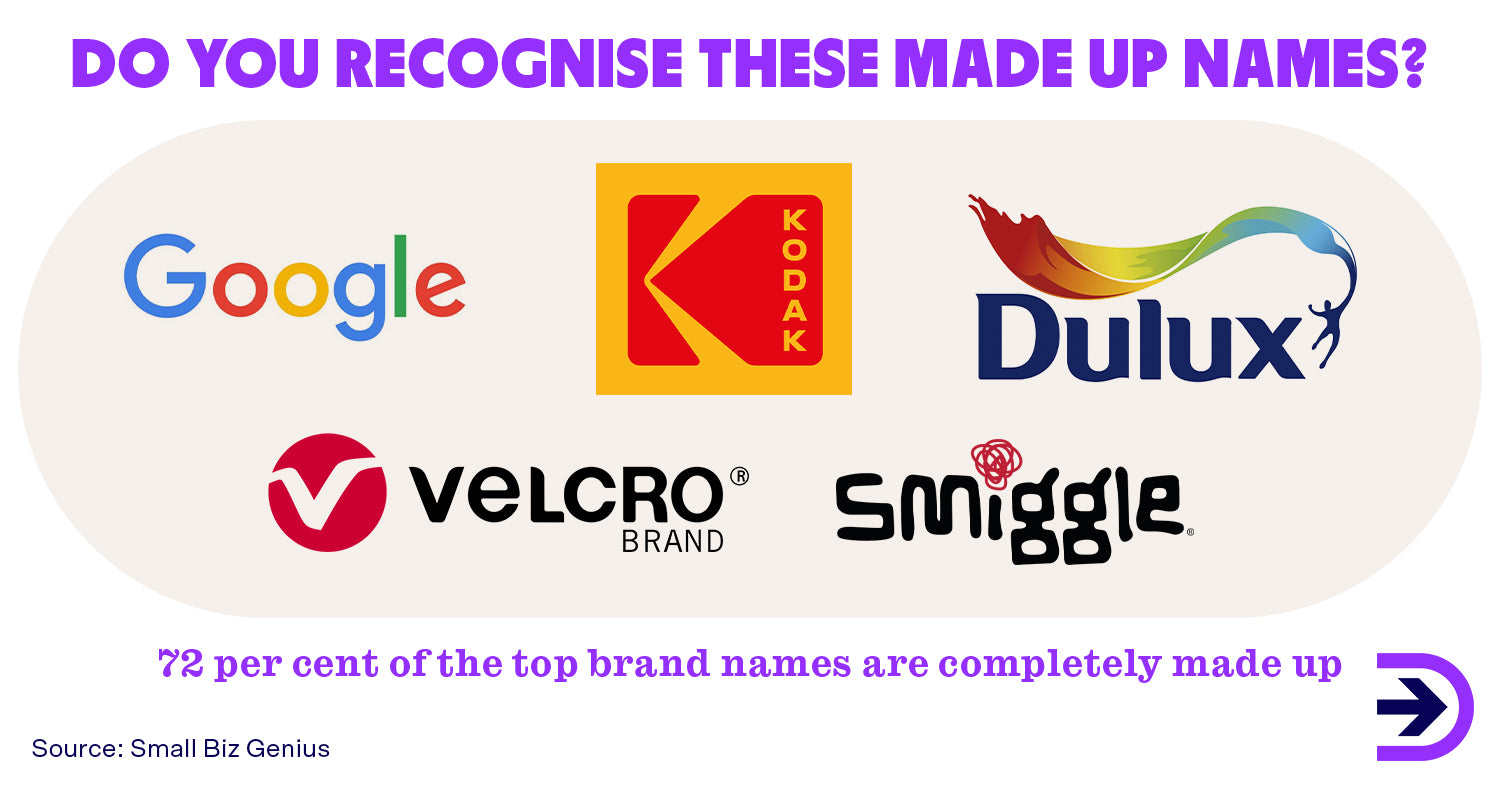
Lexical names
Similar to invented names, these business names use wordplay to create memorable names. These techniques can include onomatopoeia, alliteration, rhyming, puns and malapropism. A catchy name can create a dynamic, youthful personality for your new store. The repetition of the hard K in Krispy Kreme is pleasing to the ear and alludes to the crack of the iconic original recipe glaze. Fast food chain Lord of the Fries (a spin on the book Lord of the Flies) chose their name while on the hunt for the perfect chips and cornered the market thanks to their crispy, saucy chips and extensive vegetarian and vegan menu. Lexical names are fun and fresh, but suffer when the wordplay is too vague, too complex or too immature. Other lexical business names include Dunkin’ Doughnuts, 7-Eleven, Coca-Cola and Zoom.
Founder names
Some businesses are named after the people who started them. This method extends back to some of the earliest brands, such as Kellogg’s cereal (founded by Will Keith Kellogg) and Ford Motor Company (founded by Henry Ford). Founder names benefit from a sense of heritage and ease of trademark, but they don’t convey a business's unique value proposition and will be harder to market unless leveraging the name of a celebrity or influencer. Other famous founder-named businesses include Calvin Klein, Colgate, Cadbury and Lipton.
8 Tips For Naming Your Dropshipping Store
1. Choose an SEO-Friendly Store Name
Back when phonebooks were the best way to advertise your business, many companies changed their name to start with the letter A. Why? Because in an alphabetised phonebook, it guaranteed their name would show before any other business. These days, Google has replaced the phonebook as the main way consumers find businesses, and SEO is the best way to get businesses to the front page. While a successful SEO strategy should be implemented across all online content, an SEO-friendly title is the first place you can start.
While keyword research is a key part of SEO, you’ll want to avoid using keywords in your business name. Including high-ranking keywords in your business name or URL is not as beneficial as it used to be, particularly with the latest updates to the Google algorithm. Instead, you’ll be competing with thousands of other businesses using those keywords in their content. Best Australian Florist may be keyword-rich, but Google won’t automatically consider this business name as a relevant search term - it’s more likely to be buried among listicles, blogs and other information-rich content. You’re better off choosing a unique name that describes your business and is easily remembered. Nearly 80 per cent of users say that name recognition is the number one reason they click on search engine results. Facebook, Shopify, Reddit and LinkedIn are all unique names that rank well in search engines, allude to their businesses, and are memorable to consumers.
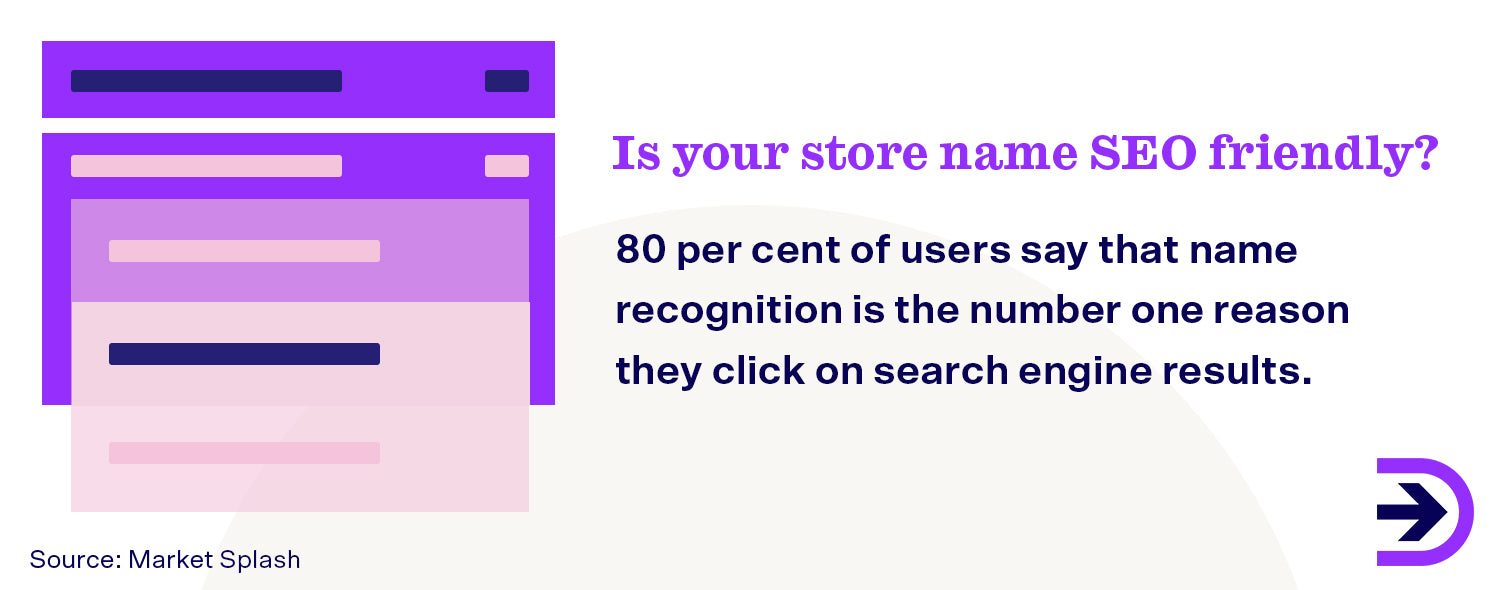
When choosing your ecommerce store name, you should also search for available social media handles. Instagram is touted as the number one place for customers to connect with brands, and 7 out of 10 Instagram hashtags are brand-specific. A consistent social media presence can raise Google rankings and increase revenue by up to 23 per cent. Use services such as Namechk.com to make sure your business name is available across all relevant platforms. Always check how your business name looks as a hashtag, or you’ll join the Hall of Failed Instagram Handles alongside #volkswagenitalia, #susanalbumparty and #CLitFest.
2. Ensure Your Store Domain Name is Available
A strong domain name is the first step to a successful online presence. It is a valuable tool that provides visibility and credibility to your ecommerce business. A good domain name also contributes to your search ranking, especially if you load your site with relevant content. That’s why it is important to research domain name availability while choosing a business name. If you’ve found the perfect dropshipping business name but the domain is unavailable, don’t worry. A domain name can be identical to the business name, or it may be closely linked. For example, Peloton uses the domain name onepeloton.com.au, a domain name that exudes authority and authenticity, while the chocolate brand Dove owns dovechocolate.com instead of dove.com, which is owned by the Dove beauty brand. Businesses can also check with site owners to determine if they are willing to sell the domain, though they may have to pay a hefty price.
3. Check Your Ideas for Trademarks & Copyrights
Before settling on a new name for your dropshipping business, you need to do a comprehensive search to ensure the name isn’t trademarked, copyrighted, or too similar to an existing trademark. These searches may include:
-
Searching for spelling variations.
-
Searching for other word forms, e.g. plurals.
-
Running searches on separate parts of the name.
-
Searching using descriptive terms.
-
Checking goods and services.
Set a Google alert to see if people mention your proposed name. If they do, then the company name may be trademarked and/or too common for your business. You can also check databases such as TM Checker for Australian trademarks and WIPO Global Brand Database for international trademarks.
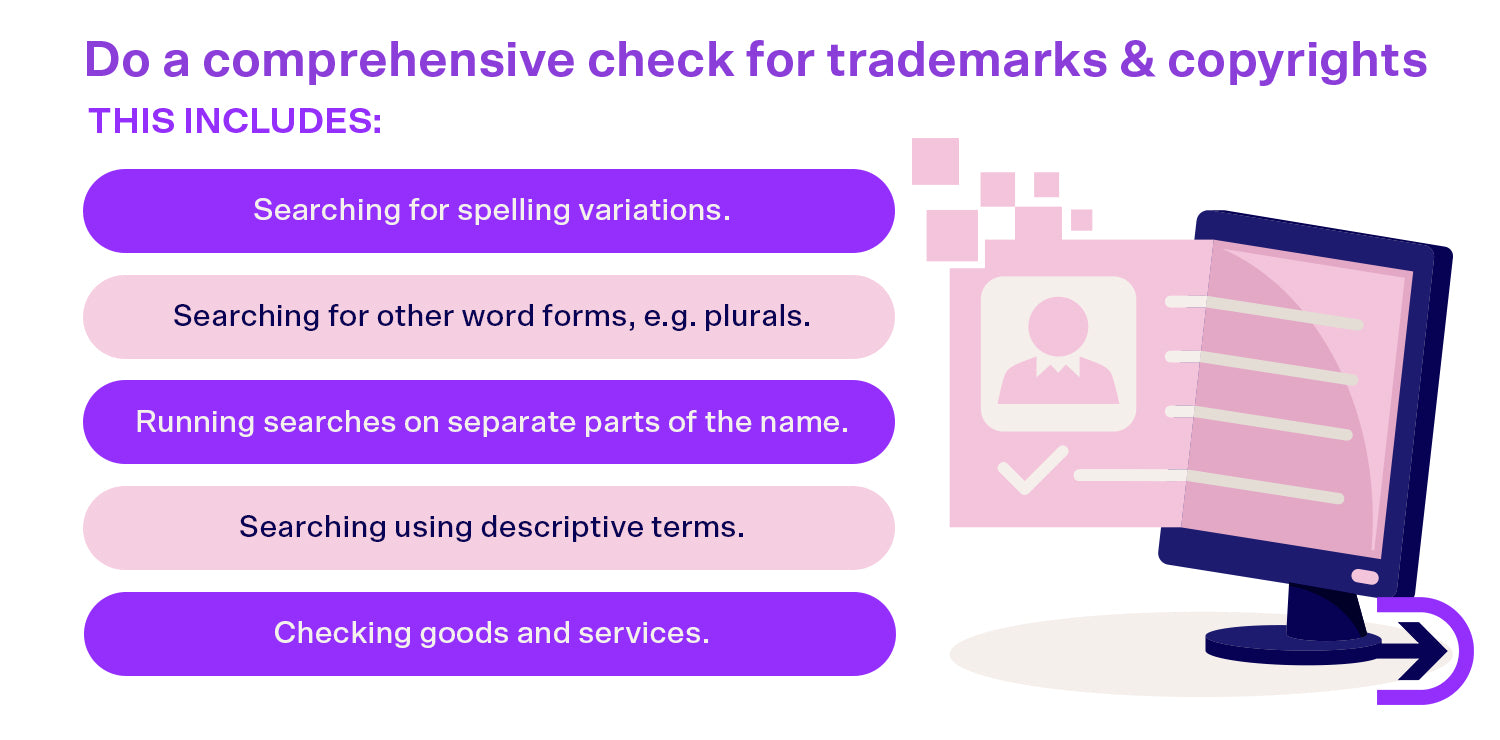
4. Make Your Name Relevant to Your Products
The more relevant a business name is to your products, the more likely customers are to remember it. Descriptive business names will convey to potential customers exactly what you sell in your online shop (such as Adore Beauty), while evocative store names may refer to unique product attributes (such as Puma shoes, designed to make your run faster). Avoid names that are vague or antithetical to your business. When Jeff Bezos was choosing a creative name for his new online book store, he initially chose Cadabra, a shortened version of the magic word ‘abracadabra’. However, his lawyer misheard the name as ‘cadaver’, meaning corpse. Thus, Amazon was chosen instead, naming the world’s largest online bookstore after the world’s largest river. Choose a name that can grow with the business as you add more products.
5. Choose a Simple and Memorable Name
Marketers often find that simple is better than clever. Why? Because sometimes being clever means being less direct. Clever names run the risk of alienating audiences who aren’t in on the joke or who find your name choice immature. Steve Jobs chose the name Apple because he liked apples, and now the brand has the highest global smartphone market share at 28.39 per cent. Apple’s success is largely down to its simple marketing strategies, such as the iconic 2000s dancing silhouettes that advertised the iPod. Simple names help customers understand your brand faster and make it easier to remember. If you find yourself agonising over a clever business name, consider that the world’s most popular search engine was originally named BackRub (because the program analysed backlinks), while Google was actually a typo.
6. Consider a Business Name Generator
Are you looking for dropshipping store name ideas? There are many free tools you can use to help generate curated, catchy dropshipping store names. These tools can be helpful in the early stages of brainstorming or as a simple creative jumping point. Dropshipping store name generators can save you hours of research and workshopping, providing thousands of unique store name ideas instantly. Even if you don’t use the names provided, you may be exposed to ideas you hadn’t considered. Some online store name generators will also search for domain availability and allow you to register available domains instantly.
Top business name generators to get your business started:
7. Test the name
Brand name testing is a surefire way to ensure your business name is the right fit for your industry and target audience. By testing different names with your customers, you’ll determine which business names resonate with your brand and target audience. There are several factors you’ll want to test your business name ideas for:
-
Spelling and Pronunciation: Can people write and say the name easily?
-
Meaning: Does the name mean what you want it to mean?
-
Association: Is the name associated with the correct industry, products or positive meanings?
-
Recall: Is the name easy to remember?
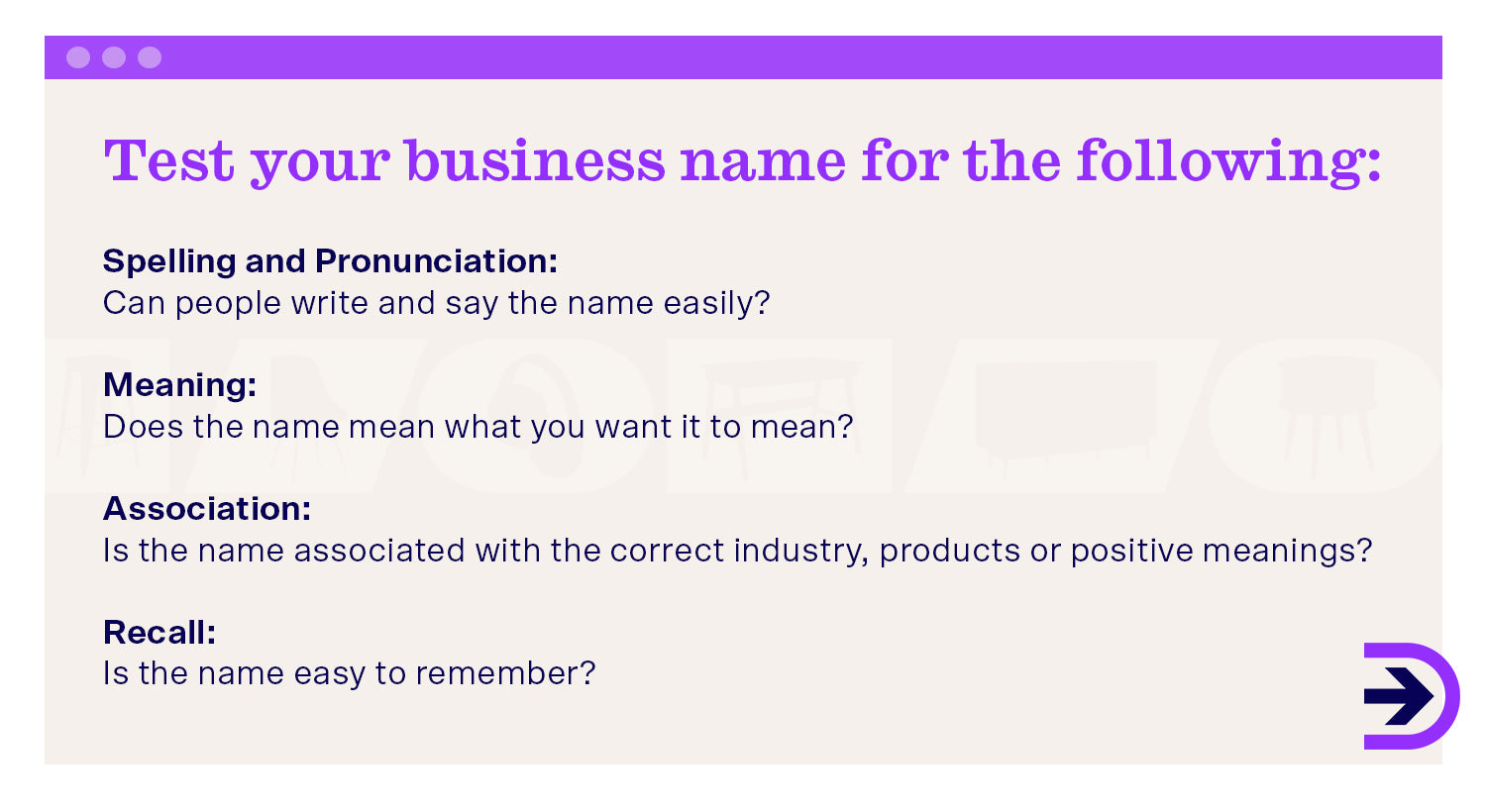
Here are some ways to test potential business names.
Ask your customers
Ask your target audience directly how they feel about a particular online store name. You can do this by sending out surveys and questionnaires or running a focus group. Ask friends, family and colleagues how they feel about the name and gauge how well they remember it. Try to get as much detailed feedback as possible. You can use tools such as Survey Monkey Audience to reach target demographics easily and quickly.
Conduct market research
Market research can help identify and segment your target market and competitors. See what customers are saying about other brands with similar online store names. Where have businesses gone wrong in the past? What names are trending and why? Does your target market prefer funny names or serious names? With proper and in-depth research, you can make an informed, data-driven decision about your online store name.
A/B testing
This method involves showing two or more versions of something to randomised target segments to see which performs better. The “A” refers to the control version, while “B” refers to the variation. A/B testing can help you make low-risk adjustments to improve your conversion rate and ROI. Test your dropshipping store names by presenting two versions of your website to visitors and use tools like Google Analytics to see which pages convert.
8. Get it trademarked
Registering a business name does not offer protection from copycats. If you want exclusive rights to your business name, you will need to protect it with a trademark. This will ensure no competitors can trade under your name (or similar names) in the same industry. Registering a trademark in Australia costs a minimum of $250 and takes at least 7 months to come into effect. Although not strictly necessary, trademarks are a useful business asset and provide legal protection for up to 10 years. They also prevent businesses from trademarking your name instead. If someone else trademarks an identical or similar business name at a later date, they would not be able to sue for copyright infringement because you used the name prior to registration. However, this will significantly impact your business’s advertising ability: you may be banned from advertising in the same location as the trademarked business, which will prevent expansion in the future.
Sometimes, business names that are already trademarked are still available for use, as long as both businesses operate in different industries. For example, Dove chocolates and Dove beauty products have the same brand name, but they operate under separate trademarks as one is in the food industry and the other is in the beauty industry.
Launch Your Online Store With Dropshipzone
Dropshipzone is your one-stop-shop for ecommerce fulfilment. Choose a great dropshipping store name and start selling products in your online store right away. Retailers can enjoy instant access to thousands of products sourced from quality suppliers around Australia. Suppliers will benefit from higher order volumes and exposure to new markets with our retailers. With new suppliers and products being added every day, there are infinite possibilities and opportunities for growth. Join us for free and start building your dropshipping business today.
